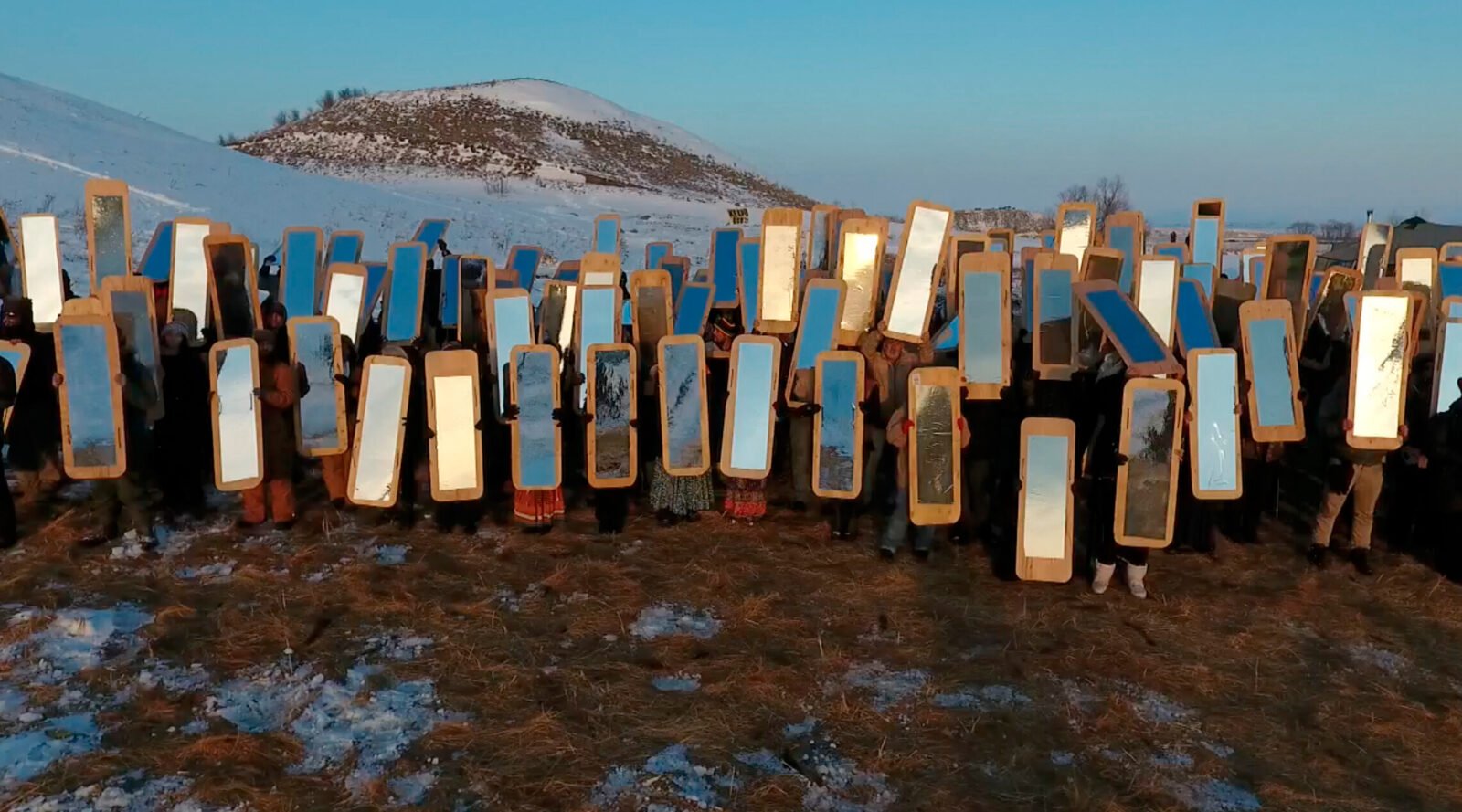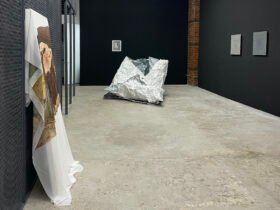Hidden in jargony press releases thanking private donors, the content of major museum acquisition announcements can be difficult to comprehend. Larger museums acquired hundreds of works in 2024, including the Brooklyn Museum, which added 330 new pieces to its collection, and the Museum of Fine Arts, Boston, which added 626 works across three acquisition groups.
We’ve sifted through the lists of museum acquisitions and compiled 10 notable additions to United States institutional collections in 2024 below. Please note that not all of these may be visible at this time. Therefore, please check each museum’s website for the most current exhibition status of each work.
National Gallery of Art – Mirror project created to support water protectors
The National Gallery of Art in Washington, DC has acquired New Mexico-based Cannupa Hanska Luger’s “Mirror Shield Project” (2016), which includes mirrors of various sizes and an approximately two-minute video. In 2016, inspired by the needs of the Water protectorswho opposed the Dakota Access Pipeline, Luger created a video tutorial for a “mirror shield” made of thin wood and non-glass reflective material that protesters could use in frontline actions to improve police image riot gear back to them. He called on people in the United States to help make them, and eventually more than 1,000 shields were delivered to Oceti Sakowin Camp near Standing Rock, North Dakota. Some were used in an action where hundreds of water protectors carried the shields as they walked in snake-like form through the Oceti Sakowin camp.
Museum of Fine Arts, Boston – 115 photos of the Black Panther Party

When photographer Stephen Shames was a student at the University of California, Berkeley in 1965, he was asked by Bobby Seale, co-founder of the Black Panther Party, to become the organization’s official photographer. For the next eight years, Shames documented the daily activities of the Black Panther Party, with a particular focus on the group’s female members, who made up approximately 65% of the organization’s membership. This year, MFA Boston acquired 115 prints of Shames’ photographs of Black Panther Party women, titled the Comrade Sisters series, including a 1972 image of a classroom at the Intercommunal Youth Institute, known as the Black Panther School, in Oakland, California. Earlier this year, 27 photographs by the artist, originally from Massachusetts, were on display at the Boston institute as part of the exhibition Comrade Sisters: Women of the Black Panther Party.
The High Art Museum – A Tribute to the ‘godmother of African-American quilting“

Harriet Powers, a woman born into slavery in Georgia in 1837 and widely regarded as the mother of African-American story quiltingis honored in the pictorial tradition pioneered by artist and aerospace engineer Carolyn Mazloomi. Her textile tribute “Ode to Harriet Powers: Mother of African American Quilting” (2024) shows Powers at work for “Pictorial quilt” (1895–89), one of hers two survivor quilts, which depict Bible stories in 15 blocks. Mazloomi was once a National Heritage Fellow for the National Endowment for the Arts very first gallery show earlier this year at the Claire Oliver Gallery in New York’s Harlem neighborhood, which featured her signature black-and-white quilt work. In contrast to her previous monochrome textile work, “Ode to Harriet Powers: Mother of African American Quilting” is bursting with earthy tones, replicated by Mazloomi in an echo of Powers’ palette. The museum in Atlanta told it Hyperallergic that the purchase of Mazloomi’s work is part of an ongoing effort to collect quilts.
Art Institute of Chicago – Four works by formidable Grandma Moses

Anna Mary Robertson Moses, better known as “Grandma Moses,” didn’t pick up a brush until she was 78. She had spent most of her life as a farmer’s wife and mother of ten children, only five of whom lived beyond their years. In her childhood, Mozes only turned to the medium when embroidery became too difficult due to her arthritis. The self-taught artist captured scenes from rural New York State and showcased her work internationally 90s and painting until she died in 1961 at the age of 101. According to at the Art Institute of Chicago in the 1940s, her art was welcomed by an American audience that rejected elitism and embraced her authenticity. The Chicago institution acquired Moses’s “The Cambridge Valley” (1942), “Thanksgiving Turkey” (c. 1940), “Home” (c. 1940) and “Burning of the Troy Bridge” (c. 1941) as gifts from the descendants of artists this year.
J. Paul Getty Museum – A Masterpiece from the Flemish Renaissance

Once thought to be lost forever, Quentin Metsys’s ‘Madonna of the Cherries’ is now on display in Los Angeles at the Getty Center’s Museum North Pavilion. Director Timothy Potts said The painting’s whereabouts were unknown after the 17th century, when the first buyer, Cornelis van der Geest, sold the work to an anonymous collector. The piece appeared again at auction in Paris in 1920, this time with the background landscape covered in green paint. After the work resurfaced as part of a Christie’s auction in 2015, the painting underwent restoration work to restore its original form. The cherries in the paintings probably refer to Christ’s passions and the fruits of heaven, while the apple represents Christ as the new Adam. These types of compositions, said Christie’s specialist Maja Markovic Hyperallergic When the work went to auction this summer, it “focused on the Virgin’s maternal tenderness that she radiated to all humanity, emphasizing personal piety and devotion to the Virgin Mary, who was seen as an intercessor for the Christian believers, the distance between the worshiper and the worshiped.” The Getty was the highest bidder for the work, paying £10.66 million (~$13.4 million) for the work in July.
San Francisco Museum of Modern Art – Martin Wong in his hometown

Martin Wong returned to his hometown of San Francisco following an AIDS diagnosis in 1994, after living in New York City for more than a decade and finding success in the Lower East Side art scene. Wong’s “DC-3” (1992), painted in the last decade of his life but before he returned home, depicts San Francisco’s Chinatown neighborhood, interrupting the viewer’s field of view with an image of an airplane flying cuts through the composition. Children’s faces peer out of round windows. Known for being social realismexplorations of queer desire and city life, and signature cowboy hatWong often included multilingual and intercultural elements in his work. SFMOMA described “DC-3” as autobiographical; Wong had grown up in San Francisco’s counterculture era, when the city became the national center of the gay rights movement. “DC-3” is the fifth work from the last ten years of Wong’s life to join the museum’s collection.
Dallas Museum of Art – A Enormous Cecile Brown Tryptic

British painter Cecily Brown was influenced by the hunting and market scenes of Flemish painter Frans Snyders to create her own slaughter scene in the oil painting ‘The Splendid Table’ (2019–2020). The work, featuring what appear to be hunting bird necks and the corpses of rabbits and deer, brought together with abstract strokes on a blood-red table, was donated to the Dallas Museum of Art by the Rachofsky Collection and the Hartland & Mackie Family/Labora. Collection. “The Splendid Table” is the first Brown painting acquired by the Dallas institute and appears in Cecily Brown: Themes and Variationswhich is now on display.
National Museum of African American History and Culture – Nat Turner’s Rebellion as imagined by Christopher Myers

The Smithsonian National Museum of African American History and Culture has acquired a nearly 30-foot-long tapestry by Brooklyn-based artist and writer Christopher Myers that explores the life of Nat Turner, who led an 1831 uprising against slavery. Filled with lips that appear stitched together, farm implements, red tears, and clashes between white and brown figures, Myers’ quilt is a “portrait of the man caught in the whirlwind of history, in a confluence of ideas and concepts, as we all,” the artist said in a statement Hyperallergic. The acquisition can be seen in the museum until June 8, 2025.
The Metropolitan Museum of Art – 300 prints by artists in Mexico

In March, the Metropolitan Museum of Art acquired 300 prints made between 1890 and 2007 by artists working in Mexico. The trove of North American prints includes Mexican-American sculptor Elizabeth Catlett’s ‘Sharecropper’ (1952), a linocut of an anonymous woman, printed in green and wearing a wide hat, intended to draw attention on the plight of black women in the South. Catlett and other artists in the acquisition group are associated with the Taller de Gráfica Popular (Workshop of Popular Graphic Art), a progressive Mexico City art collective founded in 1937 that distributed thousands of prints for left-wing causes. A selection of prints from the collection will be on display in early 2025.
Brooklyn Museum – Autobiographical leather carving

Winfred Rembert, who died in 2021, endured seven years in prison and the horrific experience almost lynched. When he was released from prison, the artist became known for his leather-carved works, a technique he learned in prison. His wife encouraged him to make art based on his life experiences, and “Looking for Rembert” (2012), acquired this year by the Brooklyn Museum as a 200th anniversary gift from trustee Stephanie Ingrassia, depicts a chain gang and reflects on the cruelty of forced labor. The work is the artist’s first to enter the collection of the Brooklyn Museum.













Leave a Reply